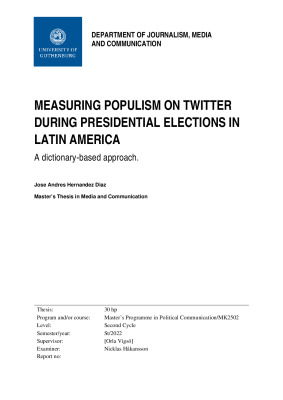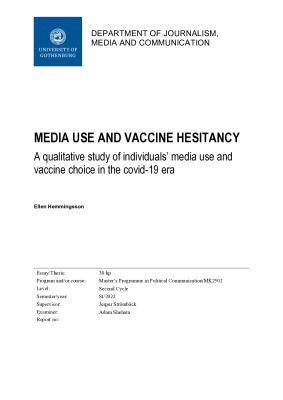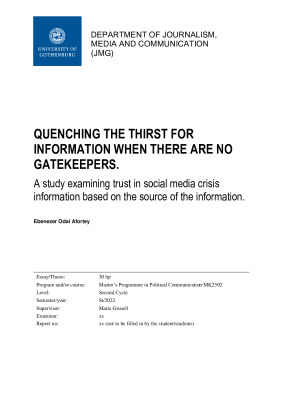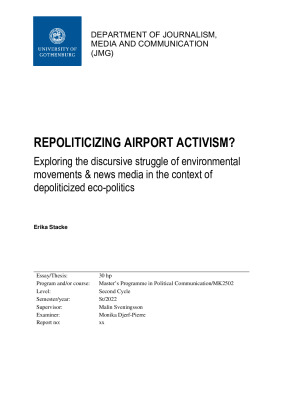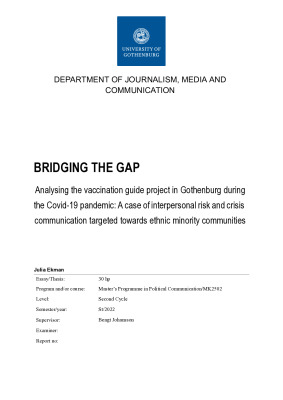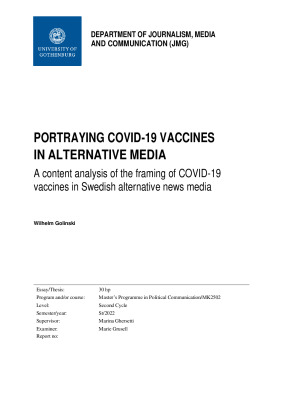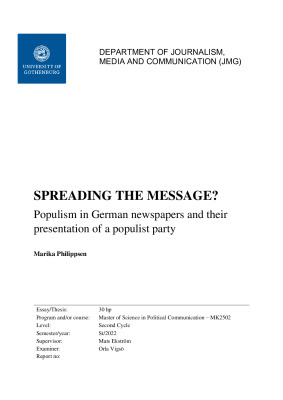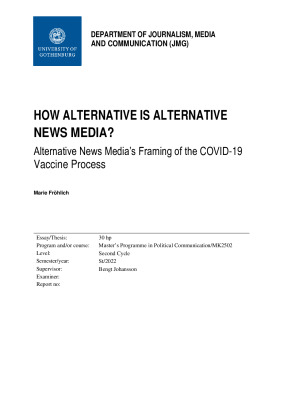This study analyses the vaccination guide project performed in Gothenburg during the Covid-19
pandemic. The project was launched as a collaboration between the local and regional governing units, city of Gothenburg and region Västra Götaland, in the summer of 2021. The aim of the project was increase Covid-19 vaccination rates in areas of the city where the population experienced vaccine hesitancy and the vaccination rates were particularly low. These low rates have been argued to be a result of e.g. having a low language proficiency as well as experiencing
cultural barriers and a low level of trust towards the Swedish society and its institutions. The
vaccination guide project to a large extent relied on interpersonal communication efforts, employing and consulting key individuals from the civil society that were to be called vaccination
guides. The vaccination guides share the target groups’ ethnic and cultural background as well as
their native language. In addition, the vaccination guides in general have a significant trust capital
among the target group due to their belonging to the same community.
This study is limited to analyse the area of Northeast in Gothenburg and its smaller districts, some of which during autumn of 2021 constituted the least vaccinated areas in Sweden. The analytical
purpose of the study is to learn more about interpersonal risk and crisis communication efforts
targeted towards ethnic minority communities. Therefore, the overarching research question to
guide this study is: How can the vaccination guides reach hard-to-vaccinate immigrant individuals with information about Covid-19 vaccination? This broad question is narrowed down to two more specific research questions that are the following:
1. How does the vaccination guide project and its implementation align with the model procedure established in previous research?
2. How do the vaccination guides perceive the possibilities of reaching hard-tovaccinate
immigrant individuals with information about Covid-19 vaccination, and the conditions of success of this communication
The central framework of this study is CERC (Crisis and Emergency Risk Communication), that relates to risk, crisis, and health communication. Anchored in research, a model procedure on how to reach hard-to-vaccinate immigrant individuals through interpersonal risk and crisis communication efforts is presented. The empirical material consists of interviews with three employees from the city of Gothenburg and region Västra Götaland as well as four vaccination guides. The interviews were analysed through a qualitative thematic analysis, identifying relevant and interesting themes to answer the research questions.
The results of the study show that the vaccination guide project and its implementation to a
significant extent has been performed in alignment with the model procedure established in
research. The vaccination guides emphasise the importance of their role in terms of reaching hardto-vaccinate immigrant individuals with information about Covid-19 vaccination. They argue that the conditions of success of this communication lies in employing trusted key individuals, such as
vaccination guides, thus making linguistic and cultural adaptions. However, the target group’s
significant level of distrust towards the Swedish society, and the spreading of misinformation, is
considered aggravating conditions for the vaccination guides’ work and the project itself.
Nonetheless, it may be concluded that local interpersonal communication efforts, such as the
vaccination guide project, can arguably be seen as a crucial step towards bridging the figurative
gap between normative Swedish society and ethnic minority communities.

